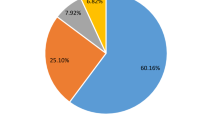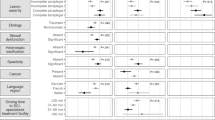Abstract
Study Design:
A retrospective analytical study.
Objective:
To determine the epidemiologic pattern of spinal cord injury (SCI) over the last decade.
Setting:
Patients admitted in the spinal cord injury unit at a university hospital between 1 January 2001 and 31 December 2013.
Methods:
A review of the clinical history of the patients was conducted. Patients were allocated according to traumatic (traffic and non-traffic accidents) or non-traumatic origin (tumour and non-tumour disease). Information about gender, age, admission and discharge date and cause, level and grade of spinal cord injury was collected. An analysis using the time–trend series was performed.
Results:
The average length of stay decreases 1.5 days quarterly, and the average patient’s age increases 0.25 year quarterly. No trend was observed with respect to the number of cases.
Conclusion:
Although the number of patients with an SCI caused by an accident has decreased and the average age of patients with an SCI has increased, it cannot be said that there has been a paradigm shift in patients with SCI.
Similar content being viewed by others
Log in or create a free account to read this content
Gain free access to this article, as well as selected content from this journal and more on nature.com
or
References
van den Berg ME, Castellote JM, Mahillo-Fernandez I, de Pedro-Cuesta J . Incidence of spinal cord injury worldwide: a systematic review. Neuroepidemiology 2010; 34: 184–192 discussion 192.
van Asbeck FW, Post MW, Pangalila RF . An epidemiological description of spinal cord injuries in The Netherlands in 1994. Spinal Cord 2000; 38: 420–424.
Cripps RA, Lee BB, Wing P, Weerts E, Mackay J, Brown D . A global map for traumatic spinal cord injury epidemiology: towards a living data repository for injury prevention. Spinal Cord 2011; 49: 493–501.
Warren S, Moore M, Johnson MS . Traumatic head and spinal cord injuries in Alaska (1991-1993). Alaska Med 1995; 37: 11–19.
Wyndaele M, Wyndaele JJ . Incidence, prevalence and epidemiology of spinal cord injury: what learns a worldwide literature survey? Spinal Cord 2006; 44: 523–529.
Albert T, Ravaud JF, Tetrafigap group. Rehabilitation of spinal cord injury in France: a nationwide multicentre study of incidence and regional disparities. Spinal Cord 2005; 43: 357–365.
Pickett W, Simpson K, Walker J, Brison RJ . Traumatic spinal cord injury in Ontario, Canada. J Trauma 2003; 55: 1070–1076.
O'Connor RJ, Murray PC . Review of spinal cord injuries in Ireland. Spinal Cord 2006; 44: 445–448.
Karacan I, Koyuncu H, Pekel O, Sumbuloglu G, Kirnap M, Dursun H et al. Traumatic spinal cord injuries in Turkey: a nation-wide epidemiological study. Spinal Cord 2000; 38: 697–701.
New PW, Rawicki HB, Bailey MJ . Nontraumatic spinal cord injury: demographic characteristics and complications. Arch Phys Med Rehabil 2002; 83: 996–1001.
McKinley WO, Seel RT, Hardman JT . Nontraumatic spinal cord injury: incidence, epidemiology, and functional outcome. Arch Phys Med Rehabil 1999; 80: 619–623.
New PW, Sundararajan V . Incidence of non-traumatic spinal cord injury in Victoria, Australia: a population-based study and literature review. Spinal Cord 2008; 46: 406–411.
Mazaira J, Labanda F, Romero J, Garcia M, Gambarruta C, Sanchez A et al. [Epidemiología de la lesión medular y otros aspectos]. Rehabilitación (Madr) 1998; 32: 365–372.
La principales cifras de siniestralidad vial 2010. 2010; Available at http://www.dgt.es/was6/portal/contenidos/es/seguridad_vial/estadistica/publicaciones/princip_cifras_siniestral/cifras_siniestralidadl011.pdf Accessed 9/1, 2012..
American Spinal Injury Association. Reference Manual of the International Standards for Neurological Classification of Spinal Cord Injury. American Spinal Injury Association: Chicago, IL, USA. 2003.
Real Decreto 1612/2010. 2010 7/12/2010 http://www.boe.es/boe/dias/2010/12/23/pdfs/BOE-A-2010-19706.pdf Accessed 23/4/2013..
Alcaraz Rousselet M, Mazaira Alvarez J . Epidemiología. In: Esclarin de Ruiz A editor.. Lesión Medular Enfoque Multidisciplinario 1st ed. Panamericana: Madrid. 2010 p 11–17.
Garcia-Reneses J, Herruzo-Cabrera J, Martinez Moreno M . Epidemiological study of spinal cord injuty in Spain. Paraplegia 1991; 28: 180–190.
Cameron MH, Elvik R . Nilsson's Power Model connecting speed and road trauma: applicability by road type and alternative models for urban roads. Accid Anal Prev 2010; 42: 1908–1915.
Beck LF, Shults RA . Seat belt use in States and territories with primary and secondary laws—United States, 2006. J Safety Res 2009; 40: 469–472.
Donaldson WF 3rd, Hanks SE, Nassr A, Vogt MT, Lee JY . Cervical spine injuries associated with the incorrect use of airbags in motor vehicle collisions. Spine 2008; 33: 631–634.
Reed MA, Naftel RP, Carter S, MacLennan PA, McGwin G Jr, Rue LW 3rd . Motor vehicle restraint system use and risk of spine injury. Traffic Inj Prev 2006; 7: 256–263.
Anuario estadístico de accidentes 2009. 2009; Available at http://www.dgt.es/was6/portal/contenidos/es/seguridad_vial/estadistica/publicaciones/anuario_estadistico/anuario_estadistico013.pdf Accessed 3/26, 2011.
Author information
Authors and Affiliations
Corresponding author
Ethics declarations
Competing interests
The authors declare no conflict of interest.
Rights and permissions
About this article
Cite this article
Sebastià-Alcácer, V., Alcanyis-Alberola, M., Giner-Pascual, M. et al. Are the characteristics of the patient with a spinal cord injury changing?. Spinal Cord 52, 29–33 (2014). https://doi.org/10.1038/sc.2013.128
Received:
Revised:
Accepted:
Published:
Issue date:
DOI: https://doi.org/10.1038/sc.2013.128
Keywords
This article is cited by
-
Dynamic body-weight support to boost rehabilitation outcomes in patients with non-traumatic spinal cord injury: an observational study
Journal of NeuroEngineering and Rehabilitation (2020)
-
Risk factors in iatrogenic spinal cord injury
Spinal Cord (2017)



